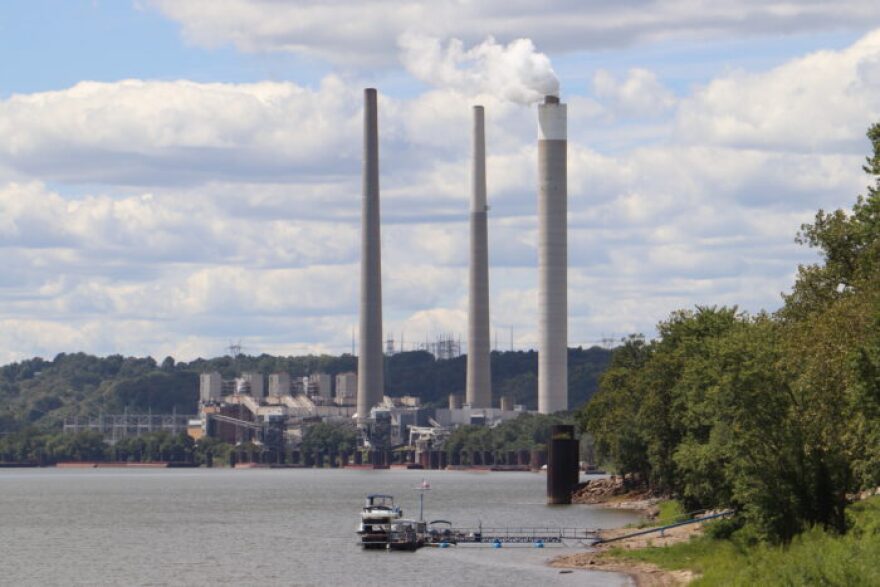In October, Louisville Gas & Electric and Kentucky Utilities and other parties came to an agreement in a case before the Kentucky Public Service Commission.
Under it, KU customers would pay $9 more a month on average, and LG&E customers would pay $5. The Kentucky commission would have to approve the pact.
The Kentucky PSC has approved a plan by the utilities to spend $3.7 billion on electricity generation projects, including two natural gas power plants costing a combined $2.8 billion.
Behind the rates paid by the companies’ customers is a hidden cost that doesn’t show up on their bills. Customers receive electricity from two aging, out-of-state coal plants that lose a lot of money.
Together, the utilities own a share of the Ohio Valley Electric Corporation (OVEC).
OVEC has a plant in Madison, Indiana, across the Ohio River from Kentucky, and another in Cheshire, Ohio, across the river from West Virginia.
An analysis adapted from a case in Michigan shows that KU and LG&E customers have paid nearly $168 million in losses generated by the OVEC plants in the past seven years.
“That’s bad by any account, and definitely costing ratepayers as compared to what it would have cost them just to self produce their own energy,” said Byron Gary, program attorney for the Kentucky Resources Council.
A West Virginia Public Broadcasting story in September showed that Appalachian Power customers in West Virginia and Virginia paid for more than $328 million in losses at the two plants from 2018 to 2024. Mon Power customers in West Virginia have paid more than $10 million.
Indiana customers of two more utilities have paid a combined $167 million in losses. That breaks down to $136 million for Indiana-Michigan Power and $31 million for CenterPoint Energy.
Indiana-Michigan Power and Appalachian Power are subsidiaries of American Electric Power. AEP owns the biggest share of OVEC, at 39%.
Other states have walked away from the OVEC plants. Michigan regulators stopped Indiana-Michigan from charging Michigan customers for the OVEC losses. Ohio lawmakers repealed a scandal-tainted bailout of the plants.
“I think it is helpful to know that other states who are not embroiled in our historical ties to coal have already determined that they are not smart for the ratepayers in their states,” said Elisa Owen, Kentucky senior organizer for the Sierra Club’s Beyond Coal Campaign.
Indiana regulators decided over the summer that Indiana customers of Indiana-Michigan would pick up the losses no longer absorbed by Michigan customers.
Devi Glick, an energy analyst at Synapse Energy Economics, testified in the Michigan case.
She adapted her analysis to calculate how much Indiana, Kentucky, West Virginia and Virginia customers were overpaying for OVEC power versus what power from the market cost.
She said the structure of OVEC’s ownership makes it hard to change anything about the way the plants operate.
“If all of them got together and were saying, ‘Yeah, this is a bad idea,’ they could make a change,” Glick said, “but it’s kind of an a nice, easy way out for them to say, ‘oh, we can’t make a unilateral decision.’”
Liz Pratt, senior communications director for LG&E and KU, said she wasn’t familiar with Glick’s analysis and couldn’t comment on it.
“We dispatch least-cost generation first, and this balanced generation approach gives us the flexibility to hedge against fuel price increases for our customers, while continuing to ensure safe, reliable and affordable service,” she said, adding, “Our residential electric rates remain well below the national average.”
Nationwide, electric utilities are scrambling to meet the demand for power from data centers and advanced manufacturing.
Meanwhile, federal policy has shifted from favoring renewables to supporting fossil fuels, including coal. The Trump administration wants to prevent the retirement of coal plants, and has used its executive power to keep at least one plant on the grid after it was scheduled to shut down.
The price of electricity has risen faster than inflation. Data centers may be driving some of that. The price of natural gas has also gone up, leading to an increase in coal generation.
The contract the region’s utilities have with OVEC runs until 2040, and utility analysts don’t expect the plants to become profitable. The Kyger Creek and Clifty Creek plants were built in 1955, making them older than the average coal plant.
Gary, of the Kentucky Resources Council, said replacement parts for coal plants are getting scarce. No new coal plant has been built nationwide since 2013.
“Nobody wants to continue making parts for Oldsmobiles anymore if they’re not going to keep making Oldsmobiles, so the parts just aren’t available,” he said. “And that’s probably only going to get worse and worse.”
Coal generates 68% of Kentucky’s electricity, according to the U.S. Energy Information Administration. While that’s far less than in the past, and lower than West Virginia’s 86%, the Republican legislative supermajority has made moves to prevent coal plants from retiring.
The Sierra Club’s Owen said that puts pressure on utility regulators, who are appointed by the governor but approved by the state Senate.
“Those commissioners are walking a political very fine line if they ever move to undo ties to coal plants,” she said. “Now, does it matter that they’re out of the state? I think it helps.”
Editor's note: LG&E provides support to Louisville Public Media.
This story was produced by the Appalachia + Mid-South Newsroom, a collaboration between West Virginia Public Broadcasting, WPLN and WUOT in Tennessee, LPM, WEKU, WKMS and WKU Public Radio in Kentucky, and NPR.




